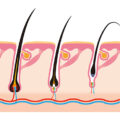Last updated on June 3, 2024
For individuals contemplating a hair transplant, it’s vital to distinguish between grafts and hairs. A graft can encompass 1, 2, 3, or occasionally 4 hairs. Here at New Hair Clinic, we measure based on grafts. It’s crucial for patients to have a clear understanding of the number of grafts they’ll receive and how many hairs are involved.
So what distinguishes a hair graft from a follicle?
From a medical perspective, a graft denotes a living tissue segment that undergoes surgical transplantation. In the context of hair restoration, a hair graft signifies the surgical relocation of a follicle or a follicular unit to the scalp.
A follicle stands for a single hair within a cluster or a follicular unit. Meanwhile, a follicular unit is a cluster that may encompass multiple hairs, typically ranging from 1 to 4 follicles.
In the context of an FUE Hair transplant, the term “graft” generally pertains to elucidating the surgical procedure of transferring a follicular unit or a group of hair, rather than a single follicle or individual hair.
To illustrate, when citing 100 grafts, it signifies the transplantation of 100 follicular units. However, it’s highly improbable that these units would comprise only 100 hairs, as a single follicular unit typically yields between 1 to 4 hairs. Consequently, in reality, the count could range from 100 to 400 hairs.
Why measure in grafts?
We furnish this information to every patient and even offer access to graft/hair count records from previous consultations. Depending on the diameter of each individual hair, there’s a finite number of grafts that can fit into a square centimeter. The spacing of grafts must be meticulous to ensure adequate blood flow for healing. Excessive grafts per square centimeter can lead to diminished graft survival rates.
For those with robust hair strands, the recommended range is 25 to 35 grafts per square centimeter. Conversely, individuals with fine hair may require 30 to 40 grafts per square centimetre. It’s essential to note that each graft contains a bit of surrounding tissue, occupying more space compared to a solitary hair sprouting naturally from the scalp. This is why achieving the same density as one had in their teenage years before experiencing hair loss can be challenging.
When patients consult with our Doctors, they assess the square centimetres that require hair restoration. Based on the thickness of the patient’s hair strands, he calculates the necessary grafts.
Regrettably, we frequently encounter patients who’ve been advised by other clinics to undergo 3000 grafts when our measurements indicate that physically accommodating 3000 grafts in the intended area is implausible. This situation often arises with clinics that offer low prices for a high number of grafts. It’s essential for prospective clients to exercise caution and recognize that if quoted at $3 per graft but presented with a substantial number for a small area, they are essentially being billed per hair.
For instance, 1200 grafts at a rate of 35 grafts per square centimetre would cover slightly over 34 square centimetres. Let’s say these 1200 grafts consist of 300 1-hair grafts, 400 2-hair grafts, 300 3-hair grafts, and 200 4-hair grafts, totalling 2800 hairs.
For individuals contemplating an F.U.E. transplant, it is advisable to inquire about the doctor’s objectives when extracting grafts. When enhancing or establishing a hairline, the focus should primarily be on utilising one-hair grafts to achieve a natural appearance. Subsequently, multi-hair grafts can be placed to achieve maximum density.
In our experience, the most informed patients tend to be the most content. That’s why we prioritise ensuring that every patient considering a transplant comprehends the distinction between grafts and hairs that can be transplanted.









